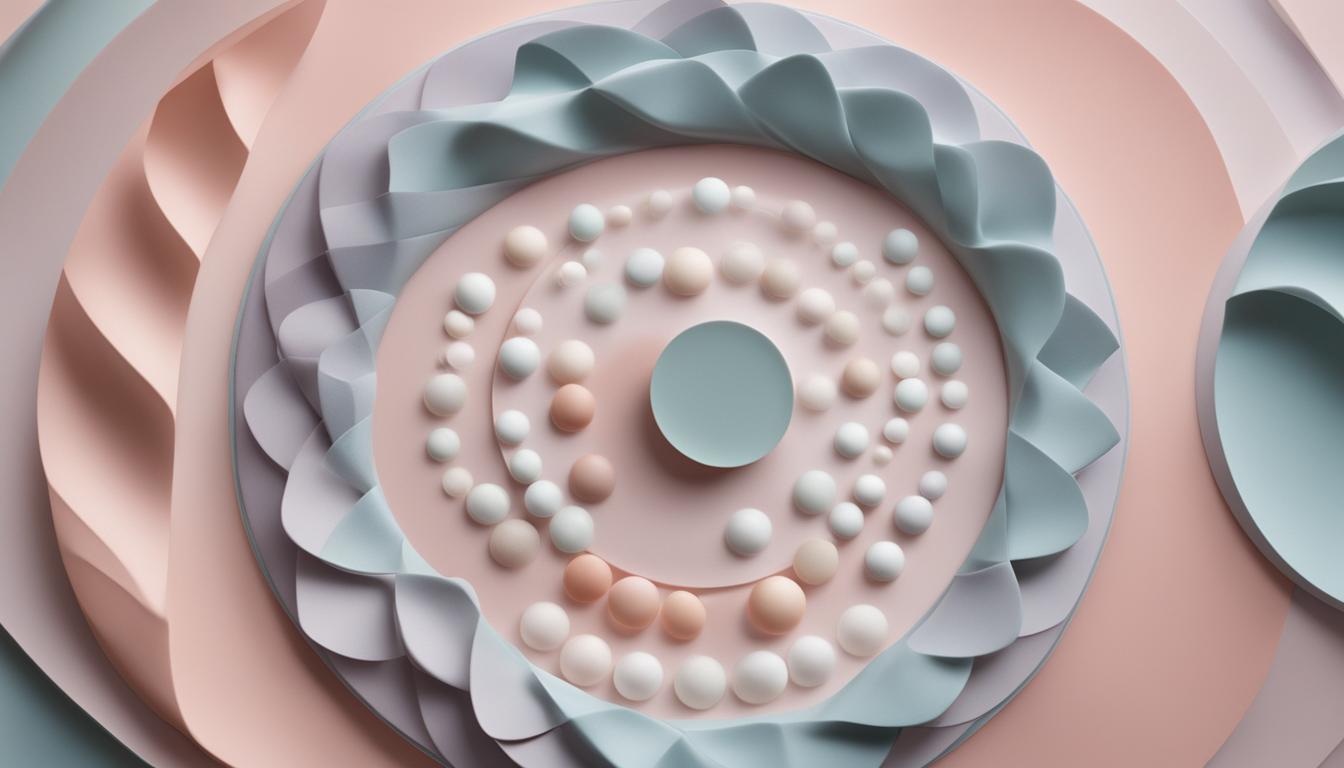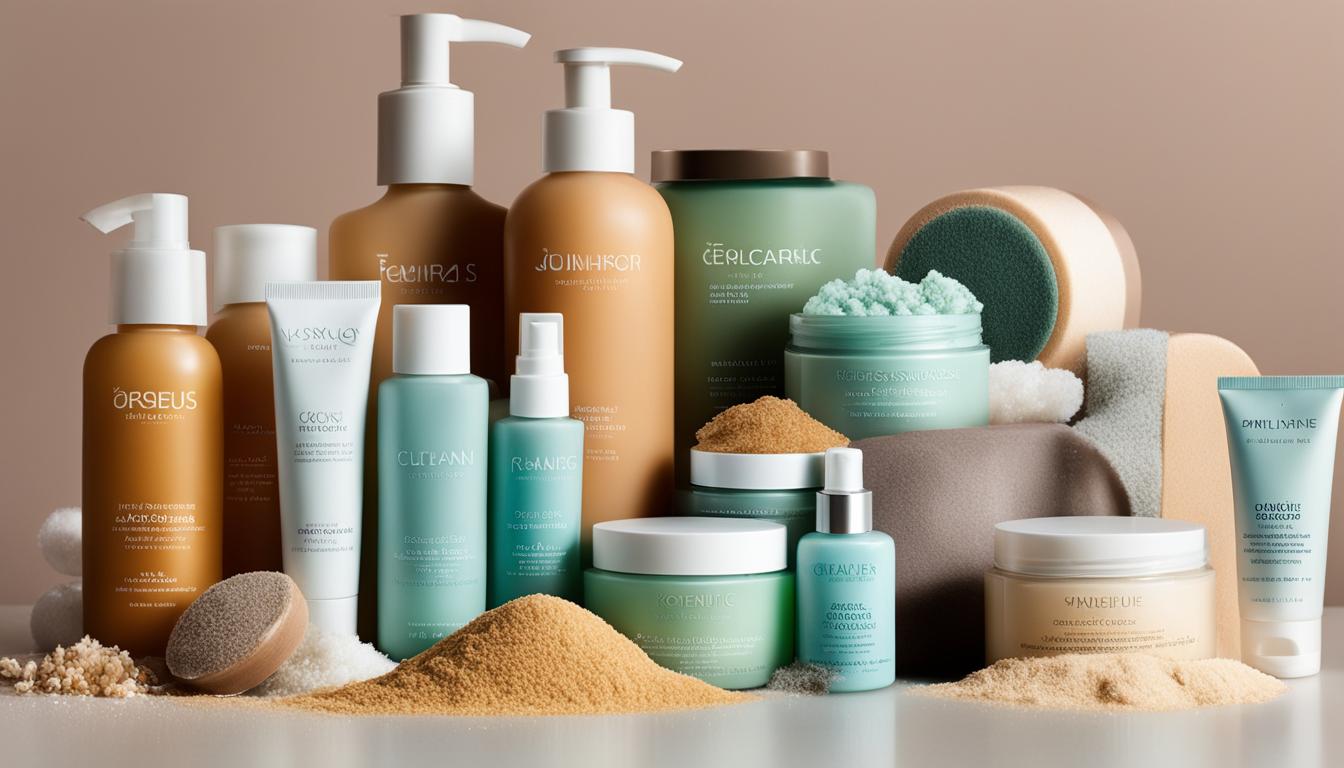Healthy skin doesn’t happen overnight. A consistent skin care routine is essential to optimize your skin’s health, fortify its defenses, and maximize your results. Whether you have normal, dry, oily, combination, or sensitive skin, following a healthy skin care routine will help you achieve and maintain a glowing complexion.
Customize your skin care regimen to address your specific needs and concerns. By incorporating professional spa treatments and using natural skin care products, you can take your routine to the next level and enhance the overall health and appearance of your skin.
Let’s explore the essential steps of a healthy skin care routine and discover how you can achieve radiant, healthy skin naturally.
Key Takeaways:
- Having a consistent skin care routine is vital for maintaining healthy skin.
- Customize your routine based on your unique skin type and concerns.
- Follow essential steps like cleansing, toning, exfoliating, masking, treating, eye care, moisturizing, protecting, and including body care.
- Choose natural skin care products to nourish and protect your skin.
- Regular professional treatments can enhance the effectiveness of your routine.
Customize Your Skin Care Routine
When it comes to taking care of your skin, one size does not fit all. Each person has a unique skin type, with specific concerns and conditions that need to be addressed. That’s why it’s important to customize your skin care routine according to your individual needs.
One of the best ways to customize your routine is by consulting with a knowledgeable esthetician. They can assess your skin type and help you identify your specific concerns, such as dryness, oiliness, sensitivity, or acne. With their expertise, they can recommend the right products and treatments that will work best for you.
Identifying your skin concerns and conditions is also crucial in customizing your routine. Whether you’re dealing with fine lines and wrinkles, hyperpigmentation, or uneven texture, choosing the appropriate products for each step of your routine can make a significant difference in addressing these issues.
By customizing your skin care routine, you can target your unique skin type, address your specific concerns and conditions, and achieve optimal results. So, book that facial appointment, consult with an esthetician, and give your skin the personalized care it deserves.

Essential Skin Care Steps
Building a solid skin care routine is the key to achieving optimal results and maintaining healthy skin. By following a series of essential steps, you can effectively address your skin’s needs and achieve the best possible outcome. Let’s dive into the fundamental components that make up a successful skin care routine.
Cleansing
The first step to any skin care routine is cleansing. This crucial step clears the skin of oil, dirt, and debris that can accumulate throughout the day. By choosing a suitable cleanser for your skin type and concerns, you can effectively prevent clogged pores, dullness, and breakouts. Whether you prefer gel, cream, oil, or foam cleansers, ensure that you cleanse your face thoroughly to create a clean canvas for the rest of your routine.
Toning
After cleansing, toning is the next vital step in your skin care routine. Toning helps to balance the skin’s pH levels, providing optimal conditions for the subsequent steps in your routine. Additionally, toners provide nourishment and hydration to the skin, leaving it feeling refreshed and revitalized. Choose toning products that suit your skin type and concerns, such as toners, essences, or facial mists, to enhance the effectiveness of your overall routine.
Exfoliating
Exfoliating is an essential step that helps to remove dead skin cells and encourage healthy skin cell turnover. By eliminating buildup and unclogging pores, exfoliation promotes a smoother, brighter complexion. Depending on your skin type and concerns, you can choose from chemical, enzymatic, or physical exfoliants. However, it’s important to remember that exfoliating too frequently or using harsh exfoliants can lead to irritation, so it’s best to consult with a professional to determine the optimal frequency and exfoliation method for your skin.
Cleanse
Cleansing is an essential step in a skin care routine. It clears the skin of oil and debris that can clog pores and cause dullness. A proper cleanse helps to remove makeup, dirt, and impurities from the skin’s surface, leaving it fresh and clean. It also prepares the skin to better absorb the products that follow, maximizing their effectiveness.
When choosing a cleanser, it’s important to consider your skin type and concerns. For oily or acne-prone skin, opt for a cleanser that helps to control excess oil and reduce breakouts. If you have dry or sensitive skin, look for a gentle cleanser that hydrates and soothes the skin.
There are various types of cleansing products available, including oil cleansers, balm cleansers, gel cleansers, and cream cleansers. Experiment with different formulations to find the one that works best for you. Remember to cleanse your face twice a day, in the morning and evening, to maintain a clean and healthy complexion.
Benefits of Proper Cleansing:
- Removes oil, dirt, and impurities
- Prevents clogged pores and breakouts
- Improves absorption of skincare products
- Leaves skin fresh and clean
“Cleansing is the foundation of a healthy skin care routine. It sets the stage for the rest of your skincare products to work effectively and helps to maintain a clear and radiant complexion.” – Skincare Expert
Tone: Essence, Facial Mist or Toner
Toning is an important step in your skincare routine as it helps to condition the skin and maximize the results of your cleansing process. Today, you have a variety of toning options to choose from, including toners, essences, and facial mists. These products not only contribute to the overall health of your skin but also provide additional hydration and nourishment.
Toning products have come a long way and are no longer harsh and drying like they used to be. They are now formulated with beneficial ingredients that can help to balance the skin’s pH level, soothe irritation, and improve elasticity. Additionally, toners, essences, and facial mists can help to prepare the skin for the next steps in your routine, allowing your serums and moisturizers to penetrate deeper and work more effectively.
When choosing a toning product, it’s important to consider your skin type and concerns. If you have dry or sensitive skin, look for gentle and hydrating toners that contain soothing ingredients like aloe vera or chamomile. For oily or acne-prone skin, opt for toners with ingredients like salicylic acid or witch hazel to help control excess oil and minimize breakouts. Combination skin types can benefit from a toner that offers both hydration and oil control.
Benefits of Toning:
- Conditions and prepares the skin for the next steps in your routine
- Restores the skin’s pH balance
- Provides added hydration and nourishment
- Soothes irritation and inflammation
- Improves the effectiveness of serums and moisturizers
Remember to incorporate toning into your daily skincare routine after cleansing. Simply apply a small amount of toner to a cotton pad or directly onto your hands and gently press it into your skin. Allow it to fully absorb before moving on to the next step. With the right toning product and regular use, you can achieve balanced, conditioned, and healthy-looking skin.

Exfoliate
Exfoliating is a vital step in any skincare routine. It helps to remove dead skin cells, encourages healthy skin cell turnover, and eliminates buildup, leaving your skin looking fresh and radiant. Incorporating exfoliation into your routine can also improve the effectiveness of other skincare products by allowing them to penetrate deeper into the skin.
“Exfoliating is like giving your skin a fresh start. It helps to unclog pores, smooth the skin’s texture, and even out skin tone,” says skincare expert Dr. Emily Thompson. “By removing dead skin cells, exfoliation promotes a more youthful appearance and can help improve the overall health of your skin.”
There are various exfoliating products available on the market, including chemical exfoliants, enzymatic exfoliants, and physical exfoliants. Chemical exfoliants, such as AHAs and BHAs, work by dissolving the bonds between dead skin cells, while enzymatic exfoliants use natural enzymes to gently exfoliate the skin. Physical exfoliants, like scrubs or brushes, physically remove dead skin cells through gentle friction.
The frequency of exfoliation depends on your skin type and concerns. For most skin types, exfoliating 2-3 times a week is sufficient. However, if you have sensitive skin or certain skin conditions, it may be best to exfoliate less frequently to avoid irritation. If you’re unsure about how often to exfoliate or which exfoliating products to use, consult with a skincare professional who can provide personalized recommendations based on your specific needs.

Selecting the right exfoliating product
- For sensitive skin: Look for gentle exfoliants with soothing ingredients like chamomile or oat extract.
- For oily or acne-prone skin: Choose exfoliants with salicylic acid or benzoyl peroxide to help unclog pores and control oil production.
- For dry or mature skin: Opt for lactic acid or glycolic acid-based exfoliants to gently remove dead skin cells without stripping the skin of its natural moisture.
Remember to always follow exfoliation with a moisturizer to replenish the skin’s hydration levels and protect it from any potential irritation. With regular and appropriate exfoliation, you can achieve a smoother, brighter complexion and maintain healthy skin cell turnover.
Mask
Face masks are an essential part of a comprehensive skincare routine. These concentrated treatments are formulated with vitamins and nutrient-rich ingredients to nourish and hydrate the skin. Masks offer a range of benefits, from firming and tightening to soothing and brightening. They are designed to target specific skin concerns like acne, dryness, and dullness, giving your skin a boost of concentrated goodness.
When choosing a mask, consider your skin type and specific concerns. For dry or dehydrated skin, opt for a hydrating mask that replenishes moisture and restores a healthy glow. If you have oily or acne-prone skin, look for a mask with purifying ingredients like clay or charcoal to draw out impurities and unclog pores. For mature skin, a firming mask can help improve elasticity and reduce the appearance of fine lines and wrinkles.
To use a mask, start with clean, dry skin and apply a thin, even layer to your face, avoiding the eye and mouth areas. Leave the mask on for the recommended time specified on the packaging, typically around 10-15 minutes. During this time, you can relax and pamper yourself. Once the time is up, gently rinse off the mask with warm water and pat your skin dry. Follow up with your regular skincare routine to lock in the benefits of the mask.
Benefits of Using Face Masks:
- Concentrated vitamins and nutrients for nourished skin
- Hydrating and firming benefits for a youthful appearance
- Targeted treatment for specific skin concerns
- Relaxing and rejuvenating self-care ritual
- Enhanced absorption of other skincare products
Integrating a face mask into your skincare routine can provide an extra boost of nutrients and hydration to your skin. Whether you want to address specific skin concerns or simply indulge in a relaxing self-care ritual, masks offer a wide range of benefits. Experiment with different masks to find the ones that work best for your skin and make them a regular part of your skincare routine.

Treat: Serum, Concentrate or Facial Oil
When it comes to targeting specific skin concerns, incorporating a treatment product into your skincare routine is essential. Treatments such as serums, concentrates, and facial oils contain high concentrations of active ingredients that work to address specific issues and provide effective results.
These potent formulas are designed to penetrate deeply into the skin, delivering a concentrated dose of active ingredients that can help to improve the appearance of fine lines, wrinkles, hyperpigmentation, acne, and other common skin concerns. By incorporating a treatment product into your routine, you can target your unique skincare needs and enhance the overall effectiveness of your regimen.
Whether you’re looking to boost hydration, brighten the complexion, or reduce the signs of aging, there is a treatment product available to suit your needs. Look for ingredients like hyaluronic acid, retinol, vitamin C, niacinamide, and peptides, which are known for their powerful skin-transforming properties. These ingredients work to nourish, repair, and protect the skin, helping to neutralize the effects of environmental stressors and promote a healthier, more radiant complexion.
Choosing the Right Treatment Product
When selecting a treatment product, it’s important to consider your specific skin concerns and goals. Take the time to research and understand the active ingredients that are most suitable for your needs. Consulting with a skincare professional or dermatologist can also provide valuable guidance in choosing the right product for you.
Additionally, it’s important to follow the instructions provided with your chosen treatment product. Some ingredients may require gradual introduction to the skin to avoid irritation or sensitivity. Applying the product consistently and as directed can help you achieve the best possible results.
Incorporating Treatment into Your Routine
The placement of the treatment step in your skincare routine can vary depending on the specific product and its formulation. As a general rule, apply treatments after cleansing and toning, but before moisturizing. This allows the active ingredients to penetrate the skin effectively and maximize their benefits.
Remember, consistency is key when it comes to skincare. Incorporating a treatment product into your routine and using it consistently can yield visible improvements over time. Whether you choose a serum, concentrate, or facial oil, make sure to give your skin the extra attention and care it deserves.
Eye Care
The delicate skin around the eye area requires special care to maintain its health and appearance. Regular eye care is essential for reducing the signs of aging, such as fine lines, wrinkles, dark circles, and puffiness. By incorporating an eye cream into your daily skincare routine, you can nourish and protect this sensitive area, leaving it looking refreshed and revitalized.
When applying eye cream, use gentle pressure to tap the product onto the skin using your ring finger. This finger exerts the least amount of pressure, ensuring that you don’t tug or pull on the delicate skin. Start from the inner corner of the eye and move outwards, covering both the under-eye area and the eyelids. This technique helps to improve circulation and lymphatic drainage, reducing puffiness and promoting a more radiant appearance.
Look for an eye cream specifically formulated for the delicate eye area. These creams are often lightweight, fast-absorbing, and non-greasy to prevent irritation. They may include ingredients like peptides, antioxidants, and hyaluronic acid to hydrate, firm, and protect the skin. Regular use of an eye cream, both morning and night, can help to preserve the thickness and elasticity of the skin, keeping it looking youthful and rejuvenated.

Key Points:
- The eye area is delicate and requires special care.
- Regular eye cream application reduces fine lines, wrinkles, dark circles, and puffiness.
- Use gentle tapping motions with your ring finger to apply eye cream.
- Choose an eye cream specifically formulated for the delicate eye area.
- Apply eye cream both morning and night for optimal results.
Conclusion
Establishing a healthy skin care routine is crucial for maintaining optimal skin health. By following essential steps, customizing your routine, and using targeted products, you can achieve healthy, glowing skin. Regular professional treatments can enhance your results.
Remember to choose the right products for your skin type and concerns and protect your skin from sun damage with SPF. Extend your routine to include body care and enjoy strong, youthful skin from head to toe.
Investing time and effort into a consistent skin care regimen is worth it. Your skin will thank you by looking and feeling its best. So start today and let your beautiful skin shine!
FAQ
How often should I follow a skin care routine?
It is recommended to follow a consistent skin care routine every day, both in the morning and at night, for optimal results.
How can I customize my skin care routine?
To customize your skin care routine, it is important to identify your unique skin type and concerns. You can then choose appropriate products and treatments for each step of your routine.
What are the essential steps of a skin care routine?
The essential steps of a skin care routine include cleansing, toning, exfoliating, masking, treating, eye care, moisturizing, protecting, and including body care.
What is the purpose of cleansing in a skin care routine?
Cleansing is essential to clear the skin of oil and debris that can clog pores and cause dullness. It is important to choose a cleanser that suits your skin type and concerns.
Why is toning important in a skin care routine?
Toning completes the cleansing process by conditioning the skin and adding beneficial vitamins and minerals. It helps to enhance the effectiveness of your skin care routine.
How often should I exfoliate my skin?
The frequency of exfoliation depends on your skin type and concerns. It is generally recommended to exfoliate 1-3 times a week using gentle exfoliants for home care, and consult with an esthetician for more potent peels and treatments.
What are the benefits of using a face mask?
Face masks provide concentrated vitamins and nutrient-rich ingredients to the skin. They deeply nourish and hydrate while addressing specific skin concerns such as acne, large pores, and dark spots.
How do serums, concentrates, and facial oils benefit the skin?
These products contain concentrated amounts of active ingredients that target specific concerns and neutralize the effects of environmental stressors. They can be incorporated into your daily skin care routine to enhance your results.
Why is eye care important in a skin care routine?
The skin around the eye area is delicate and requires special care. Regular application of eye cream maintains the health, thickness, and elasticity of this area, reducing the appearance of fine lines, wrinkles, dark circles, and puffiness.
How can I extend my skin care routine to include body care?
To extend your routine to the rest of your body, choose body care products that suit your skin type and concerns. These products will help maintain strong, youthful skin from head to toe.


